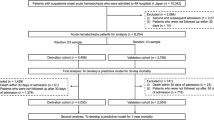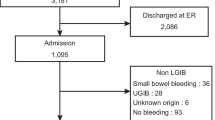Abstract
Background
Few studies have developed an easy scoring system for the short-term survival of patients with gastrointestinal (GI) malignancy.
Methods
A total of 816 terminally ill patients with GI malignancy were admitted to our palliative care unit. They were randomly divided into the investigation (n = 490) and validation (n = 326) groups. A total of 19 laboratory blood parameters were analyzed. Receiver-operating characteristic analysis was performed for each blood factor, and the area under the curve was calculated to determine the predictive value for 14-day survival after the blood test. Multivariable logistic regression analysis was performed to identify significant independent prognostic factors for 14-day mortality. To develop a scoring system for 14-day mortality, the laboratory prognostic score for gastrointestinal malignancy (GI-LPS) was calculated using the sum of indices of the independent prognostic factors.
Results
Multivariable analysis showed that 5 of 19 indices, namely total bilirubin ≥ 2.1 mg/dL, blood urea nitrogen ≥ 28 mg/dL, eosinophil percentage ≤ 0.5%, neutrophil-to-lymphocyte ratio ≥ 9.2, and platelet count ≤ 194 × 103/μL, were significant independent factors of 14-day survival. GI-LPS showed acceptable accuracy for 14-day mortality in the investigation and validation groups. GI-LPS 3 (including any three factors) predicted death within 14 days, with a sensitivity of 56–58%, a specificity of 82–87%, a positive predictive value of 48–50%, and a negative predictive value of 87–90%.
Conclusions
GI-LPS showed an acceptable ability to predict 14-day survival and can provide additional information to conventional prognostic scores.


Similar content being viewed by others
Data availability
Not applicable.
Code availability
Not applicable.
References
Ferlay J, Soerjomataram I, Dikshit R et al (2015) Cancer incidence and mortality worldwide: sources, methods and major patterns in GLOBOCAN 2012. Int J Cancer 136(5):E359–E386. https://doi.org/10.1002/ijc.29210
Lamont EB, Christakis NA (1999) Some elements of prognosis in terminal cancer. Oncology (Williston Park) 13(8):1165–1170
Stone PC, Lund S (2007) Predicting prognosis in patients with advanced cancer. Ann Oncol 18(6):971–976. https://doi.org/10.1093/annonc/mdl343
Hui D (2015) Prognostication of survival in patients with advanced cancer: predicting the unpredictable? Cancer Control 22(4):489–497. https://doi.org/10.1177/107327481502200415
White N, Reid F, Harris A et al (2016) A systematic review of predictions of survival in palliative care: how accurate are clinicians and who are the experts? PLoS ONE 11(8):e0161407. https://doi.org/10.1371/journal.pone.0161407
Pirovano M, Maltoni M, Nanni O, et al. A new palliative prognostic score: a first step for the staging of terminally ill cancer patients. Italian Multicenter and Study Group on Palliative Care. J Pain Symptom Manag 1999; 17(4):231–239
Maltoni M, Nanni O, Pirovano M, et al. Successful validation of the palliative prognostic score in terminally ill cancer patients. Italian Multicenter study Group on pa11iative care. J Pain Symptom Manag 1999; 17(4):240–247
Scarpi E, Maltoni M, Miceli R et al (2011) Survival prediction for terminally ill cancer patients: revision of the palliative prognostic score with incorporation of delirium. Oncologist 16(12):1793–1799
Morita T, Tsunoda J, Inoue S et al (1999) The palliative prognostic Index: a scoring system for survival prediction of terminally ill cancer patients. Support Care Cancer 7(3):128–133
Suh SY, Choi YS, Shim JY et al (2010) Construction of a new, objective prognostic score for terminally ill cancer patients: a multicenter study. Support Care Cancer 18(2):151–157
Hyodo I, Morita T, Adachi I et al (2010) Development of a predicting tool for survival of terminally ill cancer patients. Jpn J Clin Oncol 40(5):442–448
Gwilliam B, Keeley V, Todd C, et al. Development of prognosis in palliative care study (PiPS) predictor models to improve prognostication in advanced cancer: prospective cohort study. BMJ 2011; 343(343):d4920.
Omichi M, Konoike S, Yamada Y, et al. Development of biological prognostic score versions 2 and 3 for advanced cancer patients and a prospective study on the prediction accuracy. Comparison with the palliative prognostic index. Palliat Care Res 2017; 12(1):140–148. (in Japanese with English abstract).
Yasuda N, Nakashima O, Ohnaka T et al (2006) Novel clinical staging for patients with end-stage gastrointestinal carcinoma. Surg Today 36(1):25–29
Kadokura M, Okuwaki T, Imagawa N et al (2020) Utility of prognostic prediction models in the terminal stage of gastrointestinal cancer. J Gastrointest Cancer 51(2):515–519. https://doi.org/10.1007/s12029-019-00270-5
Katz MH (2008) Multivariate analysis: a practical guide for clinicians. Cambridge University Press, Cambridge
Halpern AL, McCarter MD (2019) Palliative management of gastric and esophageal cancer. Surg Clin North Am 99(3):555–569. https://doi.org/10.1016/j.suc.2019.02.007
Harada K, Zhao M, Shanbhag N et al (2020) Palliative care for advanced gastric cancer. Expert Rev Anticancer Ther 20(7):575–580. https://doi.org/10.1080/14737140.2020.1781620
Kadokura M, Okuwaki T, Imagawa N et al (2019) Utility of the prognostic prediction model at the terminal stage of hepatocellular carcinoma. Kanzo 60(7):229–236
Yamada T, Uchida E, Kan H et al (2010) Initial treatment plan based on predicting the prognosis for oncologic emergency of terminal colorectal cancer. J Abdom Emerg Med 30(6):805–808 (in Japanese with English abstract)
Stotz M, Gerger A, Eisner F et al (2013) Increased neutrophil–lymphocyte ratio is a poor prognostic factor in patients with primary operable and inoperable pancreatic cancer. Br J Cancer 109(2):416–421. https://doi.org/10.1038/bjc.2013.332
Qi X, Li J, Deng H, et al. Neutrophil-to-lymphocyte ratio for the prognostic assessment of hepatocellular carcinoma: a systematic review and meta-analysis of observational studies. Oncotarget 2016; 7(29):45283–45301. https://doi.org/10.18632/oncotarget.9942.
Smith RA, Bosonnet L, Raraty M et al (2009) Preoperative platelet–lymphocyte ratio is an independent significant prognostic marker in resected pancreatic ductal adenocarcinoma. Am J Surg 197(4):466–472. https://doi.org/10.1016/j.amjsurg.2007.12.057
Saito H, Kono Y, Murakami Y et al (2018) Prognostic significance of platelet-based inflammatory indicators in patients with gastric cancer. World J Surg 42(8):2542–2550. https://doi.org/10.1007/s00268-018-4527-8
Gui W, Wang X, Luo Y et al (2020) Platelet to lymphocyte ratio as a prognostic factor in patients with advanced colorectal cancer undergoing palliative treatment. Ann Palliat Med 9(5):3271–3277. https://doi.org/10.21037/apm-20-1389
Glare P, Virik K, Jones M et al (2003) A systematic review of physicians’ survival predictions in terminally ill cancer patients. BMJ 327(7408):195–198
Hui D, Park M, Liu D et al (2016) Clinician prediction of survival versus the palliative prognostic score: which approach is more accurate? Eur J Cancer 64:89–95. https://doi.org/10.1016/j.ejca.2016.05.009
Tavares T, Oliveira M, Gonçalves J et al (2018) Predicting prognosis in patients with advanced cancer: a prospective study. Palliat Med 32(2):413–416. https://doi.org/10.1177/0269216317705788
Ermacora P, Mazzer M, Isola M et al (2019) Prognostic evaluation in palliative care: final results from a prospective cohort study. Support Care Cancer 27(6):2095–2102. https://doi.org/10.1007/s00520-018-4463-z
Yamada T, Morita T, Maeda I et al (2017) A prospective, multicenter cohort study to validate a simple performance status–based survival prediction system for oncologists. Cancer 123(8):1442–1452
Valent P, Gleich GJ, Reiter A et al (2012) Pathogenesis and classification of eosinophil disorders: a review of recent developments in the field. Expert Rev Hematol 5(2):157–176
Abidi K, Belayachi J, Derras Y et al (2011) Eosinopenia, an early marker of increased mortality in critically ill medical patients. Intensive Care Med 37(7):1136–1142
Cikrikcioglu MA, Soysal P, Dikerdem D et al (2012) Absolute blood eosinophil count and 1-year mortality risk following hospitalization with acute heart failure. Eur J Emerg Med 19(4):257–263
Holland M, Alkhalil M, Chandromouli S et al (2010) Eosinopenia as a marker of mortality and length of stay in patients admitted with exacerbations of chronic obstructive pulmonary disease. Respirology 15(1):165–167
Kawai N, Yuasa N (2018) Laboratory prognostic score for predicting 30-day mortality in terminally ill cancer patients. Nagoya J Med Sci 80(4):571–582
Funding
This work was supported by the Japanese Red Cross Aichi Medical Center Nagoya Daiichi Hospital Research Grant. The funders had no role in the study design, data collection and analysis, decision to publish, or preparation of the manuscript.
Author information
Authors and Affiliations
Contributions
All authors contributed to the study conception and design. Material preparation, data collection, and analysis were performed by HN, NK, and NY. The first draft of the manuscript was written by HN and all authors commented on previous versions of the manuscript. All authors read and approved the final manuscript.
Corresponding author
Ethics declarations
Ethics approval and consent to participate
The study protocol was approved by the Institutional Review Board of our hospital (approval reference number: 2018–195). The Institutional Review Board of our hospital (approval reference number: 2018–195) waived the requirement for informed consent owing to the retrospective nature of the study.
Consent for publication
Not applicable.
Competing interests
The authors declare no competing interests.
Additional information
Publisher's note
Springer Nature remains neutral with regard to jurisdictional claims in published maps and institutional affiliations.
Supplementary Information
Below is the link to the electronic supplementary material.
Rights and permissions
About this article
Cite this article
Nagai, H., Kawai, N. & Yuasa, N. Development and internal validation of laboratory prognostic score to predict 14-day mortality in terminally ill patients with gastrointestinal malignancy. Support Care Cancer 30, 4179–4187 (2022). https://doi.org/10.1007/s00520-021-06746-0
Received:
Accepted:
Published:
Issue Date:
DOI: https://doi.org/10.1007/s00520-021-06746-0




